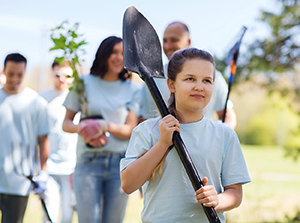 Schools and children are at the heart of every community, so demonstrating care for your community is a worthwhile undertaking that can reap the benefits of awareness and good will. While it is detrimental for a school to be “the best kept secret” in a community, guarding against the perception that we only care about our school, our kids, our objectives, and ourselves is equally important.
Schools and children are at the heart of every community, so demonstrating care for your community is a worthwhile undertaking that can reap the benefits of awareness and good will. While it is detrimental for a school to be “the best kept secret” in a community, guarding against the perception that we only care about our school, our kids, our objectives, and ourselves is equally important.
One way to build brand awareness and goodwill toward your school without descending into a perceived case of the “me-me’s” is to take a slight sidestep to build awareness for a larger-scale initiative. A campaign that focuses on doing good in a community can have a positive impact on a Christian school’s public image. It also puts the school’s name in front of new audiences. This positive image can then bring heightened awareness to the school’s mission to raise a generation of leaders and influencers who will do even more good.
A campaign with a focus that faculty, students, and parents be can passionate about sends a message that your school cares about community, state, or global concerns. This is important because the largest segment of donors, according to Prince and File (1994), are communitarian donors. These donors give where they live, and invest in the nonprofits in their communities. Schools that can demonstrate how they add value to the local community are more likely to attract this type of donor. These donors see their philanthropy as a type of business transaction, and want to work with organizations that are well managed, fiscally responsible, and making a difference in the community.
If a school is not reaching beyond its four walls into the community, then it is in essence missing an opportunity with the largest pool of potential donors. This reaching out may include community service, but the focus of an intentional campaign requires far more than a few days spent raking leaves or sweeping sidewalks. It is tied to your school’s mission and may require the allocation of time and resources, human and financial.
To help your school in thinking about a community-focused campaign, this blog post provides a few critical factors to consider before launching a campaign. Some sample campaign ideas are offered at the end.
Relevance and a Compelling Story
The choice of where to focus your school’s limited capacity of time and attention for the impact of greatest good means that the cause you choose should be deeply personal for your school. In fact, the more your school is tied to the cause, the easier it will be to build awareness and momentum. This may seem counterintuitive to the “side stepping” process, but a compelling story of why the initiative is important to your school or community is a determining factor of the campaign’s success. The case you construct for this noble cause needs to be relevant for your school.
Timeliness and Urgency
Timeliness and urgency answer the questions “Why?” and “Why now?” Consider the Salvation Army’s Red Kettle Campaign. This campaign specifically raises funds to help families, and especially children, during the holidays. The campaign is timely—it happens each year just before the beginning of the holiday season. The urgency is built into the campaign timing—without a personal act of generosity, some child will not receive food, clothes, or toys for Christmas. Do you have families in your community that need additional assistance because of a natural disaster? Is there a need and urgency to shine a spotlight on bullying, illiteracy, or health and wellness in your community? Is there a child or faculty member in your school that needs treatment for an illness? These are just a few of the ways that you can work to build awareness for a noble cause and be a blessing within your community.
Beneficiaries
One caveat is that a goodwill campaign should never be designed to exploit the people being helped. Know whom the campaign will benefit and work to gain their input and permission, as appropriate. For example, while having all of the students in a school wear pink on Fridays to build awareness about breast cancer is a worthwhile endeavor, doing the same in support of a beloved faculty member can be hurtful if not handled with discretion and loving-kindness. Many people choose to keep health concerns private, and so may not appreciate a public display, no matter how well intended. Another example over the years is when high schools have chosen to focus on suicide prevention following the tragic loss of a student. Again, this is a noble and worthy cause. Yet, it can be a source of comfort and purpose for family and friends, or an added source of pain for the family. How this kind of effort is approached makes all the difference, and limiting surprises is a good rule of thumb. Therefore, this word of caution is not to deter you from publicly demonstrating support for hurting members of your school family, but is only a warning to go slow, get permission, and be aware of unintended outcomes.
Shared Mission Provides Natural Partners
“A shared mission can turn a cause into a movement.” When expanding the scope of the school’s awareness, it is important to look for natural partners. Who else will care about your campaign? Are there already other nonprofits, community groups, or churches focused on this same mission? The cause doesn’t have to be your school’s alone. In fact, a mission shared with others in the community creates the opportunity to build new connections and strengthen ties outside your organization. A shared mission can turn a cause into a movement.
Call to Action
Before starting any campaign, it is vital to decide on the call to action. What do you hope people will choose to do in response to your passionate plea? The message is compelling, relevant, and urgent, and the donors understand they can help make a difference, but now what? How are they going to help? Are they giving money, volunteering once a week, sharing a message, or inviting their friends to a specific event? The community is with you, and in full support of your cause, but they need to know how they can help. Make sure that a specific message of action is included in every plan. In fact, sometimes it may be easier to begin with the end in mind and build the campaign plan backwards.
Media and Donor Kits
As awareness of the school’s mission builds momentum, opportunities for media coverage may also improve, along with prospects for new donor acquisition. Before being a community-focused campaign, a school should make plans for meeting the needs of both. Does the school have a press kit available? A press kit should include: a copy of the school’s logo and mission statement, the talking points of the community campaign, some student accomplishments or testimonials, and the contact person for interviews. It can also include some video footage, including a brief interview with the head of school, to make putting together a segment for video and television quick and simple. A new-donor welcome packet should also be in place, as well as a plan for welcoming and recognizing volunteers who want to join the cause. Doing good in a community creates a cycle of opportunity and awareness, and opens the door to new partners. Being prepared to maximize on those opportunities can highlight the school, its mission, and its students in a compelling way.
Sample Community Campaigns (Adapted from O’Connor 2011)
- A literacy campaign fits nicely with the mission of any school. It has statistical data and research to support the cause, has community-wide implications, and has natural partners. A sample campaign slogan might read, Fight Crime—Teach Someone to Read. Data points and research may include statistics on the widespread nature of illiteracy and its negative impacts on both juveniles and adults. Natural partners may include the police department, community officials, libraries, prison ministries, and other schools.
- A fitness campaign that emphasizes a child’s need to get up and move or play outdoors could find natural partners among several different industries. A few of these possible partners include major league and minor league sports teams, national and regional medical associations and foundations, local health and fitness stores, local hospitals, community officials, or community sports teams.
- A campaign that focuses on a local, national, or international disaster could find natural partners among churches, relief organizations, firefighters, and others focused on rendering aid during a crisis. This is also a good opportunity to invite outside individual volunteers to help.
- Finally, some existing, well-known national movement campaigns with a track record of success may have a large enough scope that a school can narrow and tailor their approach. A few examples are calls to action to get involved, find a cure, volunteer, or perform Random Acts of Kindness. Natural partners may include other nonprofits, churches, local foundations, community leaders, and other schools.
The ultimate goal of a community-focused campaign is to meet a community need and make a difference. Secondary objectives are public awareness for a great cause, improved visibility of the school within the community, a feeling of collaboration and partnership between the school and local officials, and opportunities for media and press coverage. When a community campaign is done well, doing good reaps its own reward.
References
Prince, R. A. and K. M. File. 1994. The communitarian: Doing good makes sense. The Seven Faces of Philanthropy: A New Approach to Cultivating Major Donors. San Francisco, CA: Jossey-Bass, 17–30.
O’Connor, T. 2011, March 28. “Marketing Your Mission II: Building Community through Challenge Campaigns.” Presentation at the ACSI Board and Administrator Conference, Fort Worth, TX.
About the Author
 As a Certified Fundraising Executive (CFRE), Teri O’Connor works with faith-based nonprofits to help them build meaningful and long-lasting donor relationships. Over the past 25 years, she has worked on projects ranging from $1 million to $1 billion to further the missions and ministries of her clients. She holds an MA in communication and leadership from Gonzaga University, a BS degree in business administration from Barclay College, and BA degrees in music and Bible from Vennard College. She can be reached via email at terioconnor@live.com.
As a Certified Fundraising Executive (CFRE), Teri O’Connor works with faith-based nonprofits to help them build meaningful and long-lasting donor relationships. Over the past 25 years, she has worked on projects ranging from $1 million to $1 billion to further the missions and ministries of her clients. She holds an MA in communication and leadership from Gonzaga University, a BS degree in business administration from Barclay College, and BA degrees in music and Bible from Vennard College. She can be reached via email at terioconnor@live.com.

